Back to page 1
The Design
With all of the money spent on designing and constructing Salt River Fields, how did the interior of the ballpark at the heart of the complex turn out?
 |
The short answer is “very well.”
With its spectacular view of the mountains, its perfect berms (much improved over the berms at HKS’ Gwinnett ballpark) and, yes, shade, the ballpark at Salt River Fields is a worthy centerpiece of the incredible complex.
Once you are inside the park, no matter which gate you used, you’ll want to take advantage of the 360-degree concourse and see every part of the facility. Let’s start our look with the structure in the infield.
Like at Camelback Ranch, the upper level that contains the suites and press area is elevated above the main concourse (below left). This concourse is at the rear of the main seating bowl, and to permit fans roaming there to keep one eye on the action on the field, the structures containing concession stands and restrooms are entirely on the outside of this concourse. It seemed that the number of kiosks and other features that could block your view of the field was lower than at both Glendale and Goodyear.
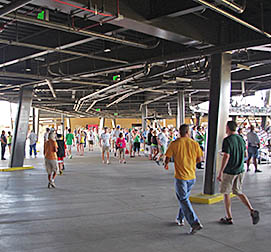 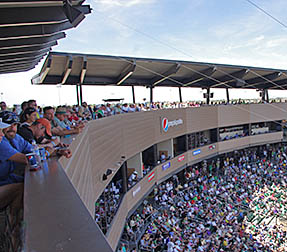 |
Another delightful difference with Glendale is that the roof (in this case, roofs) is high enough above the top of the upper level that humans can congregate there! That’s where the photo at the top of this page was taken. This area is the Pepsi Patio (above right), and it has everything you’d want: a breeze; a fantastic vantage point; lots of shade (naturally) and plenty of Pepsi. This Patio is one of three such gathering places for groups on the top of the upper level, and I found all three to be quite appealing.
Perhaps because there is ample shade, the main seating bowl seems more intimate and, well, cooler than the one in Glendale. The sight-lines are perfectly good, and the spacing between seats, rows and seating sections was more than adequate.
And this might be the best, and largest, berm seating in spring training. More than 4,000 fans can fit on the expansive hillsides, partly because the slope here is more pronounced than elsewhere. You get an idea of the lovely view from the outfield in the shot below. Note the mountains beyond the ballpark structure. Also, the light towers are uniquely shaped.
 |
But those lights have generated a little bit of controversy in their first exhibition season.
A couple of big league outfielders complained about the positioning of the lights after playing evening games. Defending AL MVP Josh Hamilton failed to catch a high fly in left field, telling reporters afterwards, “Oh my, was it bad, especially where the lights are placed … (I) tried to block out the lights. By the time the ball came down, I couldn’t get to it. It was tough.” The Rockies’ mega-star outfielder Carlos Gonzalez also misplayed three fly balls during home games at Salt River Fields the first month it was open.
So I asked HKS’ Stein about this, and he responded that a lot of deliberate thought was put into the lighting. First, they were placed to eliminate shadows on the field — “even minor shadows,” he pointed out. The look of the towers is meant to work with the overall design of the park, “so we get high functional design with high aesthetic design.” And while the brightness isn’t quite that of a big league park, it is better than the standard for Triple-A.
The two team buildings are very prominent when you look at the outfield from the main seating bowl, and when you’re walking along the outfield concourse, they are right next to you, as you can see from the photo on the left side below. On the right, you see the Rockies’ building, with the Talking Stick Spa & Resort visible in the distance. Aesthetically, I like the look of these structures better than the similarly situated buildings for the Dodgers and White Sox at Glendale. At Camelback Ranch, the two buildings are less visually compatible than at Salt River.
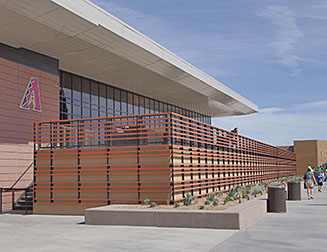 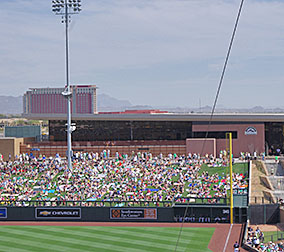 |
The Essentials
After all of the “baseball immersion” you’ve encountered around the complex, what’s it like attending an exhibition game inside the main park at Salt River Fields? How expensive is it? Are there things for kids to do (a black mark against Camelback Ranch)? And what about the all-important food choices?
Let’s talk first about what it costs to attend a game here. The first cost you’ll encounter will be for parking — maybe. If you park in the main lots near either the home-plate gates or the center-field entryway, you’ll pay $5. However, if you park in the shopping center on the southern edge of the complex, the parking is free. This isn’t “getting away” with something if you do this. The merchants want you to park there, because perhaps you’ll do some shopping or see a movie after the game. If that’s where you choose to park, you can simply enter the ballpark on the south side using the “Rockies Gate” near their practice fields.
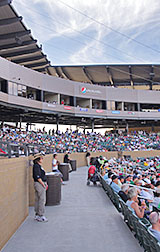 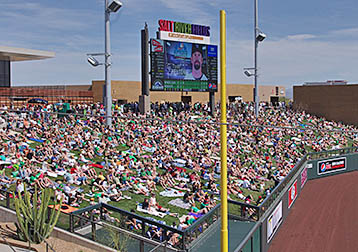 |
I’m very pleased to report that ticket prices don’t approach the astronomical dollar figures charged by the Dodgers and White Sox at Camelback Ranch, where tickets on the field side of the cross-aisle cost $30, $40 and $90 … and those are the prices for the non-premium games. Over at Salt River for either the D-backs or Rockies, the seats on the field side of the spacious cross-aisle (above left) are $25, $21 and $15 as you move farther away from the backstop … plus no games are designated as “premium.” Almost all of the reserved seats back of the cross aisle (this encompasses most of the shady area, remember) are a reasonable $20.
If you want to join about 4,000 of your closest friends on the outfield berms (the one in left field is shown above), general-admission tickets are $8, same as at Glendale and Goodyear. Other than the suites, the only other ticket option is to watch the game from one of the three heavily shaded party decks, all of which are on the upper levels in the main seating bowl (as opposed to anywhere in the outfield). Tickets that will admit you into one of those decks are $19. The Miller Lite Taste Zone on the third-base side is the one shown on the left side below.
I don’t know what the record is for most souvenir shops in one spring-training stadium, but Salt River Fields has probably at least tied it. There are three walk-in shops scattered around the outfield part of the concourse (and an early version of a layout for the park showed a fourth near home plate, but that didn’t happen). The largest of the three is near the center-field gate (below right), and it offers a balanced mixture of Rockies and D-back merchandise. There is a Rockies-themed shop near the Rockies Gate on the south side of the stadium, and naturally one for the D-backs near their gate on the north.
 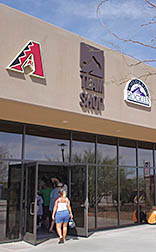 |
I was pleased that the prices of the merchandise weren’t very shocking. Most adult T-shirts were $25, $29 and $31, and caps were $27 and $28. Kids T-shirts were mostly $22 and caps were $21. They did have a variety of lapel pins (every year, Glendale annoys me by selling out of them by the middle of March), all of which were $7.
While Mo Stein was taking me on the three-hour tour, we encountered Jay Satenspiel, the Area General Manager for Ovations, the food service provider for Salt Rivers. This brings us to a discussion of one of the new complex’s greatest attributes: its concessions. “The variety (of food) here surpasses anywhere else,” Satenspiel said. “With Ovations, everything is fresh (as) we don’t allow any pre-wrapping of food. If we don’t deliver a ‘wow’ experience every single day, then we ask ourselves ‘why would the fans want to come back?'”
It is a fact that most of the food at spring-training parks doesn’t warrant sending a postcard home. Not true at Salt River. The variety and the quality are the best I’ve encountered at parks in either Florida or Arizona.
Regarding the variety, consider this: there are 55 food stands in the park, accounting for 110 points of sale. Wow! Here are some of my favorites:
- Tweety’s Pima Frybread, featuring authentic Indian fried bread in four flavors for $5, and Indian Tacos for $8
- Berrie Kabobs, with chocolate-covered berries on a sish-kabob for $5 (below left)
- Crust, known for misshapen “slices” of pizza-like goodness for $6.50 (below right)
- Home Plate Hot Dogs, featuring Chicago, New York, Arizona and Colorado dogs, all of which cost $7, plus a Salt River Dog made from bison meat topped with green chilies for $8
By the way, I feasted on a Salt River Burger Basket ($10) that featured a half-pound Angus burger with red and green chilies, served with delicious sweet potato fries
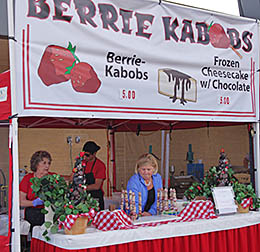 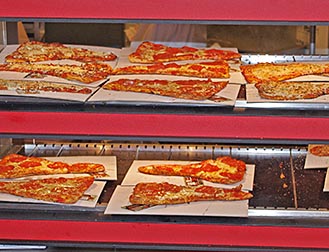 |
To summarize, there are simply outstanding food offerings here.
Some specialty beers have their own stands, including Blue Moon near the right-field foul pole and Leinenkugel on the patio on the third-base side.
I felt one feature that was lacking in the Glendale ballpark was a kids play area. The Dodgers and White Sox apparently didn’t see the need for it. Not so at Salt River, which has an adorable wiffle-ball field beyond first base (below left).
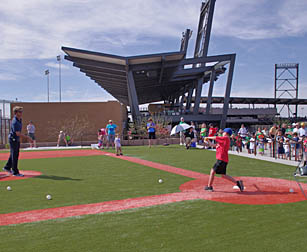  |
The ballpark boasts the largest video board of any of Arizona’s spring-training parks. At 24′ by 48′ (above right), that’s a lot of high definition, but I’ve read comments from several fans who said they couldn’t see the numbers on it clearly when the afternoon sun is shining directly on it. I didn’t find it hard to read, from either the first-base side or the third-base side.
And while not technically a “game-day-experience” feature, the landscaping throughout the complex greatly enhances the visual experience. I thought the landscaping at Camelback Ranch was spectacular, but this trumps it. Over 23,000 new trees were planted at Salt River, and over 18,000 shrubs — and all of it is vegetation native to the local area.
And the plants aren’t only scattered around the complex. Some very interesting varieties are inside the ballpark, as the two pictures below convey.
  |
Summary
So the “baseball immersion experience” of the practice facilities extends into the main ballpark. This is a very enjoyable place to watch players work out during the mornings, and play in exhibitions in the afternoon.
 |
Part of the enjoyment and authenticity of seeing all of this baseball on Indian land is the wonderful signage that is found all over the complex. As mentioned, fans are welcomed at the front gates of the ballpark in the native language of both the Pima and Maricopa Indians. The culture of the two tribes are found in a number of ways, including the Stewardship Trail on the western edge of the complex and in photos and signs around the ballpark. Even the logo of the complex incorporates a great deal. Focus EGD, formerly a division of HKS, created the logo, and “it’s been very well received,” Stein said. “Even the colors are symbolic, as the word ‘SALT’ is in red in honor of the Diamondbacks, the word ‘RIVER’ is in green because of the sustainability of the entire project, and ‘FIELDS’ is purple for the Rockies.” Great concepts — and if you want to see a close-up of this logo, look under the Ballpark Stats heading on the first page of this review.
Finally, it’s amusing that the biggest, most-expensive and downright best spring-training complex had such a modest start. When HKS’ design team started bandying about ideas for the project, it was over dinner. Naturally, suggestions started flowing, and napkins at the table provided the canvas on which artful ideas were captured. The folks at HKS’ Phoenix office had the presence of mind to keep those napkins, even as architectural renderings and engineering diagrams began taking over the project.
Mo Stein, the HKS Principal in Phoenix, thought those napkins should be preserved … and indeed they were, in lucite. One of those napkins was presented to the Rockies’ front office, and we encountered it during our tour of Colorado’s facilities building (below).
 |
You could say the concepts were immersed in lucite, but I contend that those concepts created an intensive baseball immersion, one that made Salt River Fields our 2011 Ballpark Of The Year.